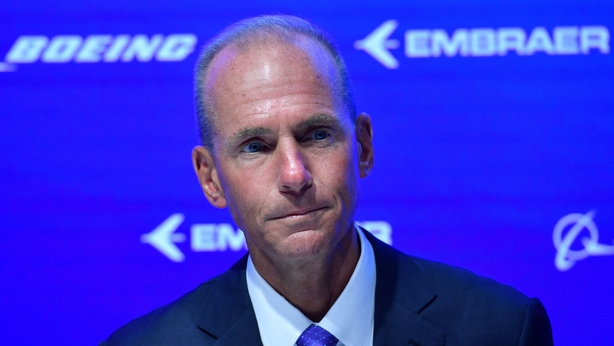US aviation giant Boeing has insisted on the "fundamental safety" of its 737 MAX aircraft but pledged to take all necessary steps to ensure the jets' airworthiness.
The statements came hours after Ethiopian officials said pilots of a plane, which crashed last month, had followed the company's recommendations, leaving 157 people dead.
The preliminary findings released by transportation authorities in Addis Ababa put the US aircraft giant under even greater pressure to restore public trust.
We need your consent to load this rte-player contentWe use rte-player to manage extra content that can set cookies on your device and collect data about your activity. Please review their details and accept them to load the content.Manage Preferences
Nearly 350 people died in two crashes involving its formerly top-selling 737 MAX aircraft in less than five months amid mounting signs the company's on board anti-stall systems were at fault.
"We remain confident in the fundamental safety of the 737 MAX," CEO Dennis Muilenburg said in a statement, adding that impending software fixes would make the aircraft "among the safest airplanes ever to fly."

The system is designed to prevent stalls but may have forced the Ethiopian and Indonesian jets into the ground.
Read more:
Ethiopia crash had 'clear similarities' with Indonesia crash
Boeing 737 MAX safety record questioned
US grounds Boeing 737 MAX amid safety concerns
Anti-stall system activated in Ethiopian crash
In an earlier statement, the head of the company's commercial aircraft division had said Boeing was ready to perform "any and all additional steps" to enhance the safety of the 737 MAX.
A report by Ethiopian investigators said the crew of the Ethiopian Airlines plane that crashed last month, killing 157 people, repeatedly followed procedures recommended by Boeing, but were unable to regain control of the jet.
The initial probe appears to confirm concerns about MCAS, with data echoing that from the crash of the Indonesian Lion Air 737 MAX 8 flight in October last year which killed 189 people.
The full report from the Ethiopian authorities has not been publicly released.
But according to a draft copy seen by AFP, shortly after take-off a sensor recording the level of the plane began transmitting faulty data, prompting the autopilot system to point the nose downwards.
"The crew performed all the procedures repeatedly provided by the manufacturer, but was not able to control the aircraft," said Ethiopian Transport Minister Dagmawit Moges, who unveiled the preliminary findings.
The report recommends "the aircraft flight control system shall be reviewed by the manufacturer," Ms Dagmawit said.
"Aviation authorities shall verify that the review of the aircraft flight control system has been adequately addressed by the manufacturer before the release of the aircraft for operations," she added.
Boeing now says it plans to release a software fix to the anti-stall system used aboard the 737 MAX aircraft in the coming weeks.
US regulators this week demanded further improvements to a proposed fix before it could be submitted for review and announced a review of the certification of the automated flight control system on the 737 MAX.
We need your consent to load this rte-player contentWe use rte-player to manage extra content that can set cookies on your device and collect data about your activity. Please review their details and accept them to load the content.Manage Preferences
The Ethiopian Airlines flight was headed to Nairobi on a clear morning on 10 March when so-called Angle of Attack sensors on either side of the nose of the plane began sending conflicting information to the auto pilot system shortly after take-off.
According to the report AFP saw, the nose of the plane pointed down four times without pilot input.
The autopilot was switched off at some point and the captain called out "pull up" three times to his first officer as the pair battled to gain control.
Three minutes after takeoff and three minutes before the crash, the captain asked the first officer to try the manual trim system, which changes the level of the plane. He replied that it was not working.
They asked to turn back, but it was too late. The plane pitched down at a 40-degree angle, smashing into a field outside Addis Ababa at about 500 knots (920km/hr).
Both engines were buried at a depth of 10 meters, in a crater 28 metres wide and 40 metres long, with fragments of debris found within a radius of about 300 metres.
"This accident was not survivable," said the report.
Citizens from over 30 countries were on board, including Micheál Ryan a married father-of-two who was from Co Clare and who worked as an engineer with the World Food Programme on projects in the developing world.
Shortly after the Lion Air crash last year, Boeing issued a bulletin reminding operators of emergency guidelines to override the anti-stall system, amid indications it had received erroneous information from Angle of Attack sensors during that disaster.

